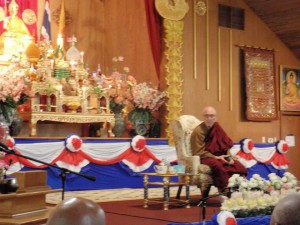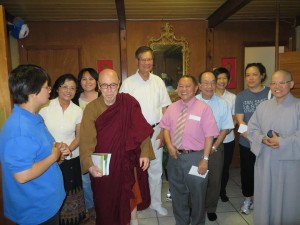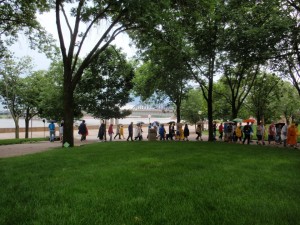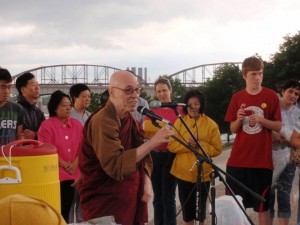The Trip is On!
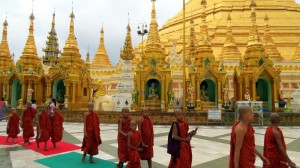 Just got the word: Tempel Smith, one of the teachers in the Dedicated Practitioner Program, will be leading a pilgrimage in Burma (Myanmar) in January….and I am going!
Just got the word: Tempel Smith, one of the teachers in the Dedicated Practitioner Program, will be leading a pilgrimage in Burma (Myanmar) in January….and I am going!
We will meet in Yangon on January 9th to visit the famous Schwedagon Pagoda (where Obama went after he met with Aung San Suu Kyi), travel to Bagan and Mandalay, take a ferry up the Irrawaddy River, make offerings in a monastery and school that Tempel helps support, and get to know many of his lovely Burmese friends. The formal trip ends on January 23rd, but several of us are staying in Yangon for a few more weeks to practice meditation at U Tejaniya’s monastery. I think Sally Armstrong and a few other Spirit Rock teachers may join us there as well!
It is a rare and precious gift to yourself to join a group of fellow practitioners to visit the country of origin from which such powerful Buddha Dharma has come. It is even more rare to go there with a Dharma guide and teacher who can help translate the ancient forms of Dharma practice and culture in contemporary terms.
Yah-hoo!
Aware of Awareness
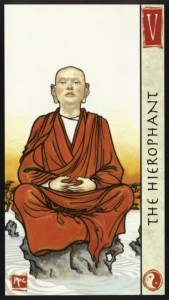 If you’re interested in trying the Dharma Seed Virtual Retreat I wrote about in yesterday’s post, it would be a good idea to listen to Guy Armstrong’s Meditation Instructions, which he gave on the morning after the first talk.
If you’re interested in trying the Dharma Seed Virtual Retreat I wrote about in yesterday’s post, it would be a good idea to listen to Guy Armstrong’s Meditation Instructions, which he gave on the morning after the first talk.
The first talk is available: here. The meditation instructions are: here. The full list of all the retreat talks is: here.
Guy’s instructions run 55 minutes. During the first 15 minutes, he gives very clear…and quite beautiful….guidance for using Awareness itself as an object of meditation. He talks about experiencing Awareness as an open field, as well as knowing it in relation to a chosen object, such as sounds, body sensations or the breath.
The next 30 minutes are silent. (So you can meditate!)
The last 10 minutes are Question & Answer.
Check it out.
(image from: Feng Shui Tarot)
Consciousness, Mindfulness and Awareness
Last Monday night, the Dharma Seed KM Group began its “Virtual Retreat” by listening to the first talk given at The Nature of Awareness: Insight Meditation Retreat for Experienced Students, which was held at the Insight Meditation Society (IMS) on April 12-18, 2013. By “Virtual Retreat” we mean that between June 17 and Aug 12, we will listen to all the available talks from that retreat…one at each of our twice-monthly meetings…and that we will listen to them in the order they were given, so we’ll have some sense of the arc of the teachings as they were presented.
 The first talk, The Attitude in Awareness, was given by Guy Armstrong. Guy talked about bringing a Relaxed, Observant, and Accepting attitude to our meditation practice, but he also spent quite a bit of time discussing the difference between three words that I’ve often heard used interchangeably: Consciousness, Mindfulness, and Awareness.
The first talk, The Attitude in Awareness, was given by Guy Armstrong. Guy talked about bringing a Relaxed, Observant, and Accepting attitude to our meditation practice, but he also spent quite a bit of time discussing the difference between three words that I’ve often heard used interchangeably: Consciousness, Mindfulness, and Awareness.
I was pretty clear on Consciousness….but Mindfulness and Awareness….those two have always been kind of a muddle.
If you want to know all the details, listen to the talk. But in summary:
Consciousness (vinnana in Pali) is the activation that takes place when the brain is “impacted” by a sight, sound, smell, taste, touch, or mental “sensation” such as a thought or emotion. One has to be alive (and not sedated) to be conscious, but one does not necessarily have to be intelligent, thoughtful or even attentive.
Mindfulness (sati in Pali) is the activity of the mind that knows when something is being sensed, perceived, understood, etc. There has to be an understanding present for mindfulness to be happening…an intention to be attentive and a knowing of it. One has to be conscious, also, but consciousness alone is not enough.
Awareness (there is no equivalent word in Pali) is a term that is used much more loosely. Sometimes it means mindfulness. Sometimes it means conscious. And sometimes it means something in between.
Hmmmm. So what IS this “Nature of Awareness”? Good question. Guess that’s why it’s the title of the retreat.
Stay tuned.
(image from: Creative Whack Pack, by Roger von Oech)
Flower, Incense, Candle
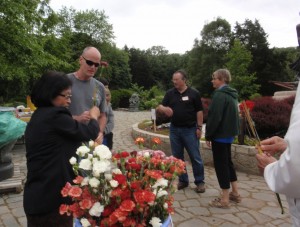 During the Vesak Day celebration at MABA last month, we were each given a bundle to carry as we walked around the grounds in a silent procession. The bundles each contained a couple of flowers, a few sticks of incense, and a fresh beeswax candle…all tied in a little “bouquet.” It seemed at the time that there must be some significance to that particular set of items, but beyond wondering about it for minute or two, I didn’t give it much thought.
During the Vesak Day celebration at MABA last month, we were each given a bundle to carry as we walked around the grounds in a silent procession. The bundles each contained a couple of flowers, a few sticks of incense, and a fresh beeswax candle…all tied in a little “bouquet.” It seemed at the time that there must be some significance to that particular set of items, but beyond wondering about it for minute or two, I didn’t give it much thought.
But then yesterday I ran across this blog post by Ajahn Sucitto, where he mentions that Vesak (or Wesak) Day “will normally center on a circumambulation of a shrine carrying flowers, incense and candles: these represent morality (sila), meditation (samadhi) and wisdom (panna), the tree limbs of the Buddhist Path.”
So now I know.
Flowers stand for the beautiful qualities of virtue (morality): Right Speech, Right Action and Right Livelihood.
Incense stands for the calming and collecting factors of meditation: Right Effort, Right Mindfulness and Right Concentration.
And the Candle stands for the illuminating power of wisdom: Right Understanding and Right Intention.
It’s The Eightfold Path!
Right there in one sweet little bundle.
Every New and Full Moon
 This weekend I listened to a talk given by Ajahn Sucitto in which he mentioned Uposatha Observance Days…which are the New and Full Moons of each month. He was mostly talking about how the monastic community gets together to reconcile differences during this time (there’s a formal recitation of the rules of conduct), but he also mentioned sitting up all night and other ways of turning more intensively toward meditation and reflection.
This weekend I listened to a talk given by Ajahn Sucitto in which he mentioned Uposatha Observance Days…which are the New and Full Moons of each month. He was mostly talking about how the monastic community gets together to reconcile differences during this time (there’s a formal recitation of the rules of conduct), but he also mentioned sitting up all night and other ways of turning more intensively toward meditation and reflection.
It sounded beautiful.
So I looked it up on Access to Insight:
“Uposatha days are times of renewed dedication to Dhamma practice, observed by lay followers and monastics through out the world of Theravada Buddhism…
“Lay people observe the Eight Precepts on Uposatha days, as a support for meditation practice and as a way to re-energize commitment to the Dhamma. Whenever possible, lay people use these days as an opportunity to visit the local monastery, in order to make special offerings to the Sangha, to listen to Dhamma, and to practice meditation with Dhamma companions late into the night.
“For those not closely affiliated with a local monastery, it can simply be an opportunity to step up one’s efforts in mediation, while drawing on the invisible support of millions of other practicing Buddhist around the world.”
OK, well I’m not quite ready to give up eating dinner (which is what is required if you observe Eight Precepts), but I do what to find a way to be a part of this world-wide sangha. Sitting up all night to meditate isn’t really an option at this point either. But maybe sitting longer…say for two hours….might just be possible.
The next Uposatha day is the Full Moon on Sunday, June 23rd.
I’ll let you know how it goes.
(image from: a stack of cards I have with no box, no name, no one to credit)
Wish You Were There
In case you missed Bhikkhu Bodhi at the Thai Temple in St. Louis, his talk is posted here on YouTube. The quality is not that good, but I think it’s still worth checking out. There are also photos of the event posted here on the Buddhist Council of Greater St. Louis Facebook page.
Here’s a sampling:
Read All About It
 One of the many interesting things Bhikkhu Bodhi said at his talk on Tuesday night, was that he practices Metta meditation in a slightly different form than the one traditionally taught. Instead of directing his attention to various categories of people….self, friend, neutral person, difficult person, all beings…and then cultivating a sense of friendliness and goodwill toward each of them in turn, he said that he just reads the news and then lets his heart open to the specific instances of suffering that are happening — right here and now — all over the world.
One of the many interesting things Bhikkhu Bodhi said at his talk on Tuesday night, was that he practices Metta meditation in a slightly different form than the one traditionally taught. Instead of directing his attention to various categories of people….self, friend, neutral person, difficult person, all beings…and then cultivating a sense of friendliness and goodwill toward each of them in turn, he said that he just reads the news and then lets his heart open to the specific instances of suffering that are happening — right here and now — all over the world.
Even more than that. Let your heart be broken, he said, without reacting in violence or sinking into despair, and it will have a transformative effect on the way to respond to the world.
Give Me Five
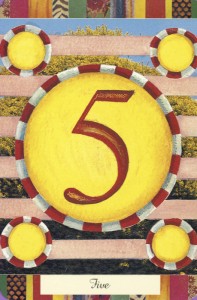 Last night Bhikkhu Bodhi gave a beautifully clear, lively and inspiring talk at the Thai Temple in St. Louis. It was recorded, so I hope to be able to post a link to it in the near future. In the mean time, here’s a list of Five Spiritual Faculties (also called Strengths or Powers), which was the basis of his talk.
Last night Bhikkhu Bodhi gave a beautifully clear, lively and inspiring talk at the Thai Temple in St. Louis. It was recorded, so I hope to be able to post a link to it in the near future. In the mean time, here’s a list of Five Spiritual Faculties (also called Strengths or Powers), which was the basis of his talk.
Faith (saddha), also known as Trust or Confidence, which is the uplifting quality that inspires practice, dispels doubt, and balances Wisdom.
Energy (viriya), also known as Effort or Persistence, which is the vital force that enlivens our practice, dispels laziness, and balances Concentration.
Mindfulness (sati), also known as Bearing in Mind, which reminds and reconnects us with our intentions, dispels heedlessness, and balances all the other factors.
Concentration (samadhi), also known as Collectedness, which is the calming quality that bring peace, dispels distraction, and balances Energy.
Wisdom (panna), also known as Discernment, which is the result of seeing clearly into the nature of all things, dispels ignorance, and balances Faith.
How Am I Doing?
 Last night our KM group began discussing Chapter 17 of Dancing with Life, by Phillip Moffitt. We talked about what we’re trying to “accomplish” in our practice, what we thought it might be like to experience “cessation of suffering,” and how to tell if we’re making any “progress” toward that end. Here’s what Phillip has to say (from page 196 of the hardback edition):
Last night our KM group began discussing Chapter 17 of Dancing with Life, by Phillip Moffitt. We talked about what we’re trying to “accomplish” in our practice, what we thought it might be like to experience “cessation of suffering,” and how to tell if we’re making any “progress” toward that end. Here’s what Phillip has to say (from page 196 of the hardback edition):
“….do not measure your progress by the number or amplitude of dramatic moments [in meditation] you have had, but rather periodically ask yourself:
Is my practice stronger?
Do I suffer less?
Do I cause less suffering?
Do I have a clearer, calmer perspective in my daily life?
“What matters is that you make your life your practice. Making your practice the core of your life is cessation in the sense that you cease pursuing the illusionary and cease trying to find well-being and meaning in what can never yield freedom.
“For the most part you will not know where you are on the path to cessation, only that you are indeed on the path….
“The hints you will encounter in your practice fall into three categories:
Those moments when you know you are suffering less because of your practice
Those moments when you feel the wholeness or sweetness that comes with choosing to dance with life in this manner
Those moments when you know your mind is free.”
(image from: Housewives Tarot)
Walkin’ in the Rain
There was a nice turnout for the Walk to Feed the Hungry on Sunday…even though it rained! Bhikkhu Bodhi was there (yay!!!) He gave a little talk about Buddhist Global Relief, which he founded, and chanted a blessing. It was lovely.
The event was sponsored by Buddhist Council of Greater of St. Louis. They’ve posted lots and lots of photos on their Facebook web page.
Here are a few of my favorites:

